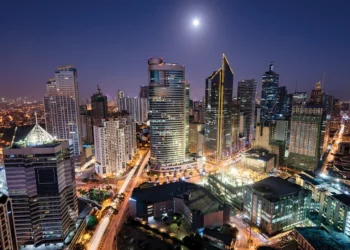As the World Series of Poker celebrates its 50th Anniversary, IAG delves into what makes this incredible annual tournament series so special and how it has stood the test of time.
For anyone with even a passing interest in poker, the first time setting foot inside the Rio All-Suites Hotel and Casino’s massive Pavilion Room during the annual World Series of Poker is the closest you’ll get to a religious experience.

Spanning a massive 54,910 square feet, for two months each year this cavernous space is blanketed by 232 poker tables which, when full, produce a wave of raw energy – the air tingling with nervous anticipation and the walls reflecting a cacophony of sound from 2,000-odd chip stacks shuffling through sweaty fingers.
For players the world over, this is Mecca – the spiritual home of poker complete with its own annual pilgrimage to the holy city of Las Vegas.
And as it celebrates its 50th year in 2019 – a phenomenal milestone in its own right – the WSOP is showing no signs of slowing down. From its humble beginnings in 1970, when Benny Binion invited seven of the world’s best poker players to compete in a winner-takes all series of cash games at the Horseshoe Casino, this year’s WSOP smashed all previous records with 187,298 entries across the expansive 89-event schedule.
The 2019 WSOP Main Event – without doubt the Holy Grail of poker – saw a massive 8,569 players stump up the US$10,000 entry fee, second only to the 8,773 who sat down for the 2006 Main Event at the very peak of the global poker boom.
So big that it fills three full conference spaces – known as the Pavilion, Amazon and Brasilia rooms – there were this year a total of 519 poker tables in play.
And a litany of records fell by the wayside too: a 51% year-on-year increase in the total number of entries series-wide, the most prize money ever awarded with a combined US$293 million, 62 events with US$1 million-plus prize pools and 12 separate events with fields of 5,000 or more.
The numbers, coming at a time when there have never been so many live events for players around the world to choose from, are stunning and a testimony to the unique legacy this one-of-a-kind spectacle has created.
“Fifty years is a long time for any company to be in business but we are fortunate at the World Series of Poker that our founding was so long ago and was the first of its kind in this industry,” explains WSOP Vice-President of Corporate Communications, Seth Palansky.
“The WSOP has a legacy and the trust of the players, which are important components.”

For the players, the great attraction of the WSOP is its rich history steeped in mystique. The WSOP Main Event is the tournament where more legends have been created than in all other tournaments combined: from “The Grand Old Man of Poker” Johnny Moss who took down the first two renditions in 1970 and 1971 (against six and seven opponents respectively) to Doyle Brunson who did the same in 1976 and 1977, Stu Ungar in 1980 and 1981 and the great Johnny Chan who not only beat fields of 152 and 167 to win back-to-back Main Event titles in 1987 and 1988 but came within a whisker of making it three in a row when he finished runner-up to Phil Hellmuth in 1989. For the record, Chan finished 560th in this year’s Main Event for a US$24,560 payday.
The WSOP was also the scene of the single most important moment in poker history when the aptly named Chris Moneymaker topped a field of 839 starters to win the 2003 Main Event. As the story famously goes, Moneymaker – a struggling accountant at the time – qualified for the Main Event by winning a US$89 satellite tournament playing online which he then parlayed into victory in the world’s most prestigious event and a US$2.5 million payday. His success captured the imaginations of amateur players across the United States and resulted in a major spike in numbers in the ensuing years, climbing to 2,576 players in 2004, 5,619 in 2005 and 8,773 in 2006 when another brilliantly named persona, Jamie Gold, claimed the biggest ever Main Event prize of US$12 million.
A flatter payout structure saw this year’s winner, Hossein Ensan, collect US$10 million for his efforts, however it is more than just the players who benefit from the modern-day behemoth that is the World Series of Poker.
The WSOP brand, acquired by Caesars Entertainment (then known as Harrah’s) in 2004 as part of its US$37 million purchase of the Horseshoe Club Operating Company, has proved one of its more important assets during an otherwise difficult decade for the US casino giant.
 While Caesars, which runs the WSOP via its Caesars Interactive Entertainment (CIE) arm, doesn’t provide specific financials on its annual poker festival, the company did reveal that the US$266 million it awarded in prize money in 2018 came after subtracting between 4% and 10% for operation of the event – a total of between US$11.1 million and US$29.6 million. That likely puts direct revenue from the annual summer series somewhere in the vicinity of US$18 million. Caesars also earns year-round revenue from its WSOP Circuit events – a secondary series of events comprising 33 stops across the US – and from its WSOP.com online poker site which operates in Nevada, New Jersey and Delaware, but doesn’t publicly release annual breakdowns of CIE’s financials.
While Caesars, which runs the WSOP via its Caesars Interactive Entertainment (CIE) arm, doesn’t provide specific financials on its annual poker festival, the company did reveal that the US$266 million it awarded in prize money in 2018 came after subtracting between 4% and 10% for operation of the event – a total of between US$11.1 million and US$29.6 million. That likely puts direct revenue from the annual summer series somewhere in the vicinity of US$18 million. Caesars also earns year-round revenue from its WSOP Circuit events – a secondary series of events comprising 33 stops across the US – and from its WSOP.com online poker site which operates in Nevada, New Jersey and Delaware, but doesn’t publicly release annual breakdowns of CIE’s financials.
However, as Palansky explains the real value of the WSOP for Caesars is in the ancillary, “filling up hotel rooms in the summer in Las Vegas, restaurants, shows, pools, clubs. It’s about bringing all the people to Las Vegas that the WSOP does.”
Also arriving in Las Vegas for WSOP each summer are around 2,000 temporary staff, including dealers “borrowed” from around the country as well as HR, compliance, PR, accounting, legal, food and beverage, retail, marketing, cashiers, payout clerks, surveillance, security, cocktail servers, convention staff, and audio and video teams.
They join the WSOP’s 45 full-time staff who spend 11 months a year planning and running this extraordinary event.
“A lot has changed in 50 years in poker, but the WSOP has been so successful because it exists to serve all poker players,” says Palansky. “Anyone who dreams of playing poker, dreams of coming to Las Vegas and competing in the World Series of Poker.”
One for the ages
In a year that saw records fell by the dozen, Iranian-born German poker pro Hossein Ensan proved a fitting champion as he outlasted the massive 8,569-person field over 10 long days to win the 2019 WSOP Main Event.
 At 55, Ensan was the oldest Main Event champion in 20 years and one of only two in the last 10 years to be aged over 40. Incredibly this was not only the first time he had cashed in a WSOP event but also the first time he had ever played the Main.
At 55, Ensan was the oldest Main Event champion in 20 years and one of only two in the last 10 years to be aged over 40. Incredibly this was not only the first time he had cashed in a WSOP event but also the first time he had ever played the Main.
Entering the final table – itself played over three days – as dominant chip leader, Ensan looked unbeatable for the first two and returned on the last day holding 63% of the chips in play, with just he, Dario Sammartino and Alex Livingston remaining.
He stumbled briefly on the home leg, with Livingston taking the chip lead for a few moments before fading to hit the rail in third and Sammartino then stealing an early advantage in the first hand of heads-up play.
After showing a better two pair in that hand to hold a near 2:1 chip advantage, the highly-regarded Italian was most analysts’ pick to ride the momentum to victory, but instead it was Ensan who proceeded to dominate the next three hours before finally finishing Sammartino off in a dramatic final hand that saw his KK fade flush and straight draws. Incredibly, it was also the first time in the history of the WSOP that the winning Main Event hand has been either AA or KK.
Ensan is no stranger to success. He won a European Poker Tour (EPT) Prague Main Event for US$754,000 in 2015, has made two other EPT final tables and holds a WSOP International Circuit ring from winning an event in Rosvadov, Czech Republic, in 2017.
His career winnings before this year’s WSOP stood at a respectable US$2.7 million but that all pales into insignificance now that he has another US$10 million to play with. Not bad for two weeks’ work.





























